How We Spec'd It: 2017 Porsche 911
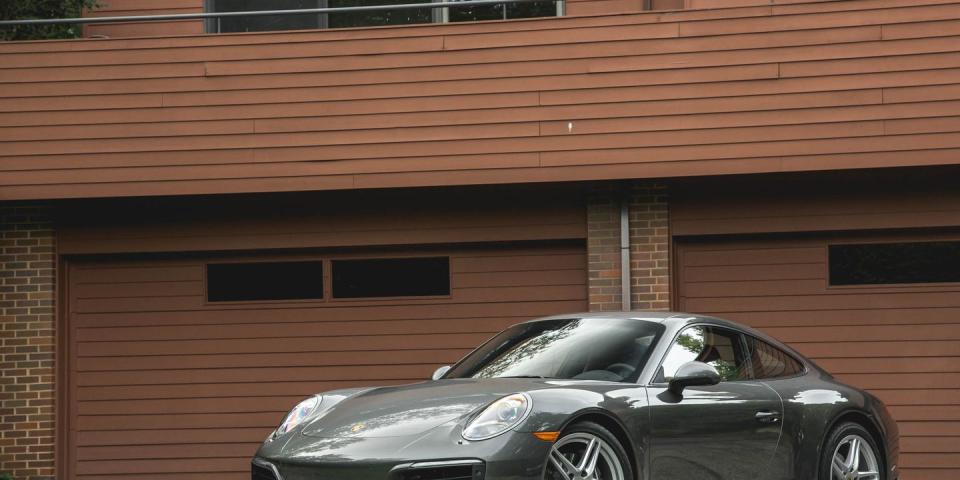
The Porsche 911 celebrated its big Five-Oh a couple of years back, and not only is it still going strong, but it even resembles the original (unlike the equally successful and even older Chevrolet Corvette). As you’d expect, the 911 has profited from countless upgrades scattered over roughly seven generations. The new-for-2017 mid-cycle refresh applies to the 991 generation introduced in 2012 and is referred to as 991.2 in Porsche circles.
Unlike most cars that rely on altered sheetmetal creases or rejiggered grilles to energize mid-cycle sales, the 991.2 got a major redo. The most important was a new flat-six engine, downsized to 3.0 liters for both the Carrera and Carrera S models. Fitted with twin turbos, these engines provide a 20-hp bump for each model as well as vastly more torque at much lower rpm. A revised seven-speed manual transmission with a dual-plate clutch and taller gears is tailored to the greater torque. And, in the comprehensive Porsche way, these latest models also get a revised suspension with wider rear tires and stronger brakes. A new infotainment system with an upgraded screen improves the interior, while Porsche Active Suspension Management (adjustable dampers) has been made standard. The car also gets rejiggered grilles—front and rear.
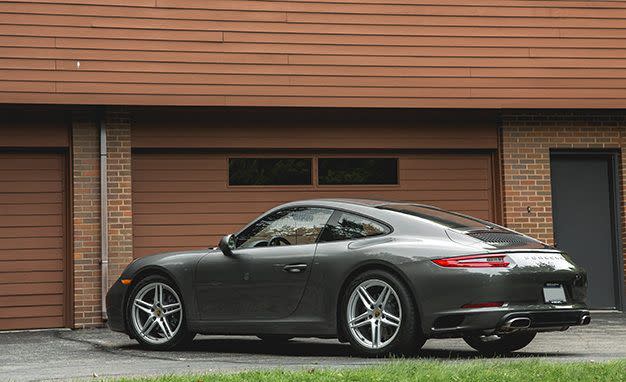
This is normally where we’d tell you, hypothetically, which options we’d choose were we looking to buy a new 911. But, in this case, since my 2007 BMW 335i was getting long in the tooth, I ordered a 991.2 as my 65th-birthday present. I did consider a new BMW, as I had grown to love my E90 3-series, but the new F30 3-series doesn’t steer or handle nearly as well as the old 3. Nevertheless, my wonderful experience with my 335i did influence my 911 selection, as you’ll see below.
The 911 lineup includes the standard Carrera as well as the S, in coupe, targa, or cabriolet form, with rear- or all-wheel drive. The body style was easy, as I’m a coupe guy and own a Jaguar E-type convertible as well as a few motorcycles to provide open-air experiences. I nixed the sunroof because it just fries my bald head, adds 20 or 30 center-of-gravity-raising pounds, and costs $1490 (metal) or $1990 (glass). Ditto for all-wheel drive, which adds 110 pounds, 1.7 inches of drag-increasing width, and $6900—none of which is desirable. Besides, if you can’t handle winter with two-wheel drive and snow tires, you don’t know how to drive. Same reason to select the manual transmission. Yeah, the PDK dual-clutch automatic posts faster acceleration times, but the advantage is all at the launch. Once you’re rolling, the manual is just as quick—and it saves $3200 and 44 pounds. What can I say? I’m a cheap engineer at heart.
The biggest decision was between the base Carrera and the S. I went for the base car for three reasons. First, though it’s down 50 hp to the S, it’s up 70 hp and down 400 pounds compared with my 2007 335i. As a result, it runs the quarter in 12.4 seconds at 117 mph—more than a second quicker, with a double-digits-faster trap speed. That’s enough of a performance bump for this senior citizen—especially for my everyday chariot. Another reason was noise. A wonderful aspect of the 335i was that, despite its sport suspension and high-performance summer tires, it was very quiet on a smooth road, minimizing fatigue and letting occupants enjoy the sound system and make Bluetooth phone calls. Knowing that the 911 would be louder, I wanted to minimize the increase and figured the 19-inch wheels with slightly higher-profile tires would be more placid than the 20-inchers on the S. The clincher was the 14 grand extra for the S. Even at 911 prices, value counts—especially with a multifarious, gilded, and truly labyrinthine options list still to negotiate.
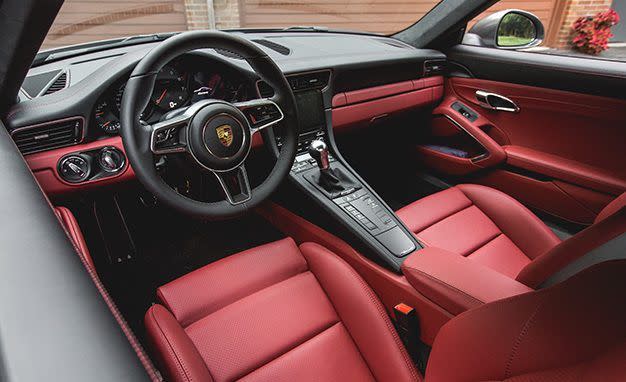
My color choice began inside. I’m a sucker for red interiors, and Porsche offers a delectable combination of black and Bordeaux Red for $4280. As pricey as this choice is, it didn’t include the leather-covered dash—black with subtle red stitching—and the matching door panels. Those two options added $1770 and $690 to the bottom line. I also selected the Leather Interior package ($1090), which covers the bright aluminum trim on the dash, doors, and console with red-and-black leather. Spending a weekend with our long-term Cayman S last year convinced me that the brightwork dazzled too much on sunny days.
These interior choices steered my exterior color to something in the silver/gray/black family. I was intrigued by the new Graphite Blue Metallic, which looks much like the color used to paint old Monarch lathes, but the hue had a little too much blue to complement the Bordeaux Red interior. So I went for the Agate Grey Metallic for $710.
I decided on the 18-way Adaptive Sport Seats Plus ($3465), one of my priciest choices. Having dodged corpulence in my old age, I can appreciate the extra lateral support of the Sport Seats Plus. The non-power version of this seat costs only $440, but I wanted the adjustable seat-cushion angle, thigh support, and lateral support that I had on my BMW. Unfortunately, these seats come with gray plastic frames that look a bit déclassé. As with just about everything else, Porsche will cover them in leather—for $1870—but that was too rich for me.
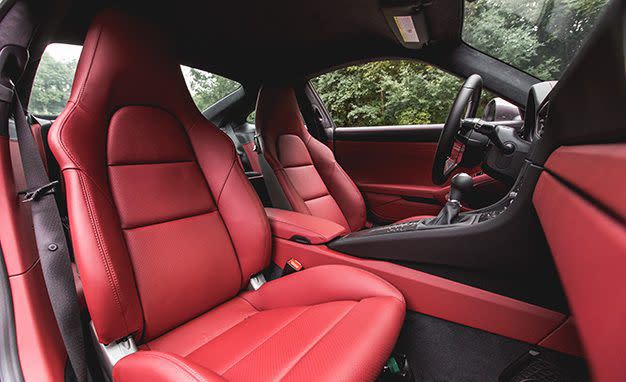
At least when you select one of the power-seat options, you are offered a premium package for a mere additional $620. This includes the Porsche Dynamic Light System, which swivels the headlights during cornering, provides some sort of range control, and adds headlight washers, heated front seats, and automatically dimming mirrors inside and out. If selected separately, those items would have come to $1880. I also checked the boxes for the luggage net in the passenger footwell and the smoking package, which comes with an additional electrical outlet on the console. Best of all, both of these two options are free!
Finally, a few odds and ends. My BMW had the keyless-entry-and-drive system called Comfort Access, which lets the driver keep the fob in his or her pocket. It works very well, and I had become used to it, so I invested the exorbitant $1090 to get Porsche’s Entry & Drive. In another nod to the BMW, I selected the heated multifunction steering wheel ($470). Steering-wheel buttons are very handy, and with a planned move to Colorado on the horizon, the warm grip sounded great.
Finally, I selected the wheel center caps with a colored Porsche crest for $185 and the no-cost change in model designation on the engine lid. Mine simply reads “911.”
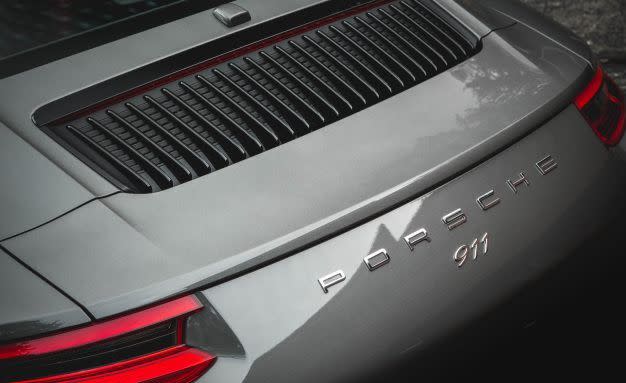
These selections added $14,370 to the 911 Carrera’s base price of $90,450, bringing the total to $104,820. A lofty sum indeed—but a comparative bargain in the 911 world, which is populated by, say, a Carrera 4S cabriolet stickering around $150K. Of course, there’s still a few thousand to be spent on paint protection film and perhaps an extended warranty, but in for a penny, in for a pound.
Now that the car has arrived, I’m delighted by my choices. I’ve never seen another 991 with the leather-covered aluminum trim, and it looks great. The plastic seat frames are not that visible and actually complement the Agate Grey Metallic finish on the exterior. And the sweep of the roofline from the base of the flush windshield, curving onto the uninterrupted roof and tapering smoothly into the tail, is sublime. From the driver’s seat, the 911 responds smartly and feels very strong, even though I am respecting the 4000-rpm limit during the 2000-mile break-in period. I hope to be driving it for the next decade or so.

You Might Also Like

 Yahoo Autos
Yahoo Autos 